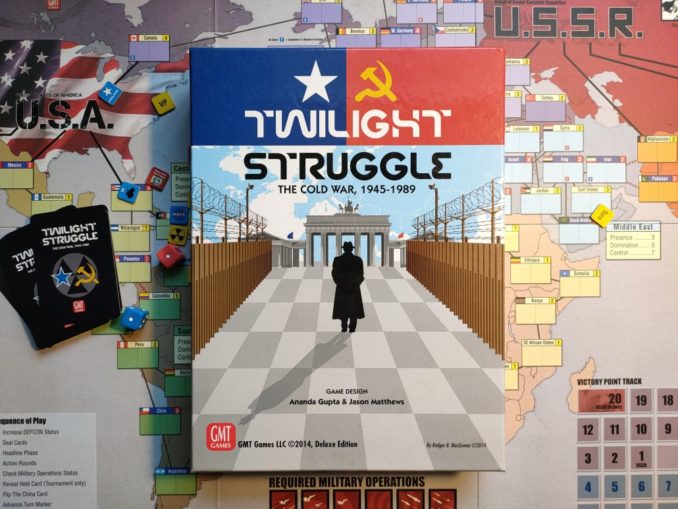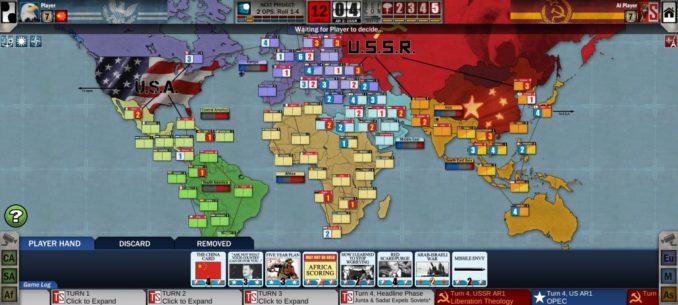
If you think of board games, traditional favourites such as Monopoly, Cluedo or Risk probably come to mind. However, in the late 1990s and 2000s a new generation of board games started being developed that are generally considered superior to those old classics. This revival was led by titles such as Settlers of Catan (1996), Carcassonne (2000) and Pandemic (2008). The game we are looking at today is a strategic two player game released in 2005 – Twilight Struggle, The Cold War 1945 – 1989, by GMT Games. For 6 years running, this game was voted the best board game of all time on Boardgamegeek.com.
Overview
In Twilight Struggle (TS) players choose to play one of the superpowers – either the U.S or USSR. The objective is to win the Cold War. It is set across 10 gameplay turns spanning 1945 to 1989. Within each turn there are 6 to 8 action rounds where the players take turns in making game actions. A typical game will be completed in 2 to 3 hours. The main game dynamic is to try and build geopolitical influence on behalf of your superpower. This allows you to control countries thereby gaining dominance or control of different regions on the map.

Basic Play
The game is centred around playing Event Cards every action round. These events mirror real events during the cold war. The events favour one or other of the superpowers, or are neutral. For example, the Marshall Plan helps the US, whilst the Suez Crisis helps the USSR. Sponsoring the Olympic Games helps either. Different cards are put in the draw pile depending on whether it is early, mid or late war. For example, The Iron Lady card in late war increases US influence in the UK, but decreases it in Argentina. Cards can either be played for their event or for their operations value. In practice, most of the time you use the operations value of the card to directly place influence tokens in countries. However, if you use an opponent’s card for its operations value you also trigger their event, helping them. The main strategy of TS is therefore to strategically place influence on the map and in managing these good and bad events to your advantage. The game is all about dealing with crises and having to make trade offs. For certain events and operations – such as coups – dice are rolled, so you have to weigh up the probability of success. The game can be quite frustrating until you get used to the rhythm of positive things happening on your go only to be largely undone on your opponent’s go. Once you get used to this balance of power approach, it becomes tense and addictive.

Winning
Each region on the board has a Region Scoring card. When these cards are played the players score victory points (VPs) depending on how well they control
the region. VPs are also awarded for various events. A player reaching 20 VPs ahead of the other wins the game. If the game makes it to the final turn ie. 1989, the final regional points are tallied up and the player with the most VPs at the end wins. A player automatically loses the game if they trigger nuclear war.
Realism
The main game dynamic of battling for influence very elegantly captures the essence of the Cold War itself. The geographies of the US and USSR are actually dead spaces on the game map – all of the action happens in other countries. There is also no direct military action between the superpowers – the only time this occurs is if a player triggers nuclear war, which forfeits the game. Different countries have different stability ratings which make it harder or easier to take control. For example, it is very hard to wrestle control of the UK away from the US if you are the USSR player, whilst many African countries can swap allegiance very easily. There are also battleground countries (coloured red) which have additional rules making them more lively. The middle east is chock full of battleground countries. One criticism of the game is that the USSR player is stronger in the early war phase whilst the US player will be more likely to win if the game reaches the late war phase.
Coups
A powerful way of quickly establishing influence in a country is to stage a coup using the operations value of a card. Less stable countries are easier to coup. However, if you coup a battleground country you lower the DEFCON rating by 1. The DEFCON rating determines where coups are possible and how close the world is to nuclear war – at DEFCON 5 you can coup anywhere, at DEFCON 4 Europe is prohibited, for example. Africa and South America are fair game whenever. If you coup a battleground country at DEFCON 2 you trigger nuclear war, and forfeit the game.

Military Operations Requirements
Players are required to complete a certain number of coups or War Events per round determined by the DEFCON level, or they are penalised by deducting VPs. I particularly like this feature of the game which is clearly out of the neo-realism textbook of geopolitics. Players must be aggressive, but not recklessly so. One of the event cards is called ‘Flower Power’ which favours the USSR by making it harder for the US to start wars in places like Korea. These connections to real history and geography are what make TS so compelling. You end up with a good knowledge of the history of the Cold War.
Space Race and China
The game cleverly incorporates the Space Race by having a space race track that players can advance along separately from the main game. You can discard event cards that would help your opponent by using them up on the space race track. Achieving milestones such as landing on the moon brings special abilities to your superpower. China is represented in the game by the China Card which gets passed to the other player once played. This game dynamic represents how both superpowers tried to play China to their advantage during the Cold War; with Henry Kissinger actually coining the phrase “playing the China card”.
Learning to Play
Learning to play TS is relatively quick once you understand the order of play, how to place influence and how to conduct coups. It takes a while to learn to play the game well though because you need to learn the key event cards and when to take advantage of them, or mitigate them. A quick example – the Brush War card allows a player to start a war in a country with a high chance of success if the opposing player doesn’t control the neighbouring countries. I learnt about this the hard way when my opponent used it to take control of Italy, a popular target for this card. This took me completely by surprise and shifted the balance of power in Europe to the USSR in one go. It is also surprisingly easy to trigger nuclear war by mistake when a beginner. This can make TS feel complicated and overwhelming at first. However, the learning curve is actually quite fast once you play a few games.

App Version
I’ve recently got back into TS playing the android app version against the computer AI opponent. It can be difficult to find someone to play the actual board game with, so the app is an excellent way to learn the game on your own and play online. So far I’ve been very impressed with the app version. Some reviewers have complained about the AI cheating or dice roles not being random, but I haven’t noticed this. It is very slick and the soundtrack creates a lot of atmosphere and tension. That said, the physical board game is a thing of beauty. It’s not cheap but is well worth the price for the quality and period feel.
In conclusion, if you like strategy games, cold war history, or have a megalomaniac streak, Twilight Struggle is well worth checking out.
© text & images JimmySP 2022



